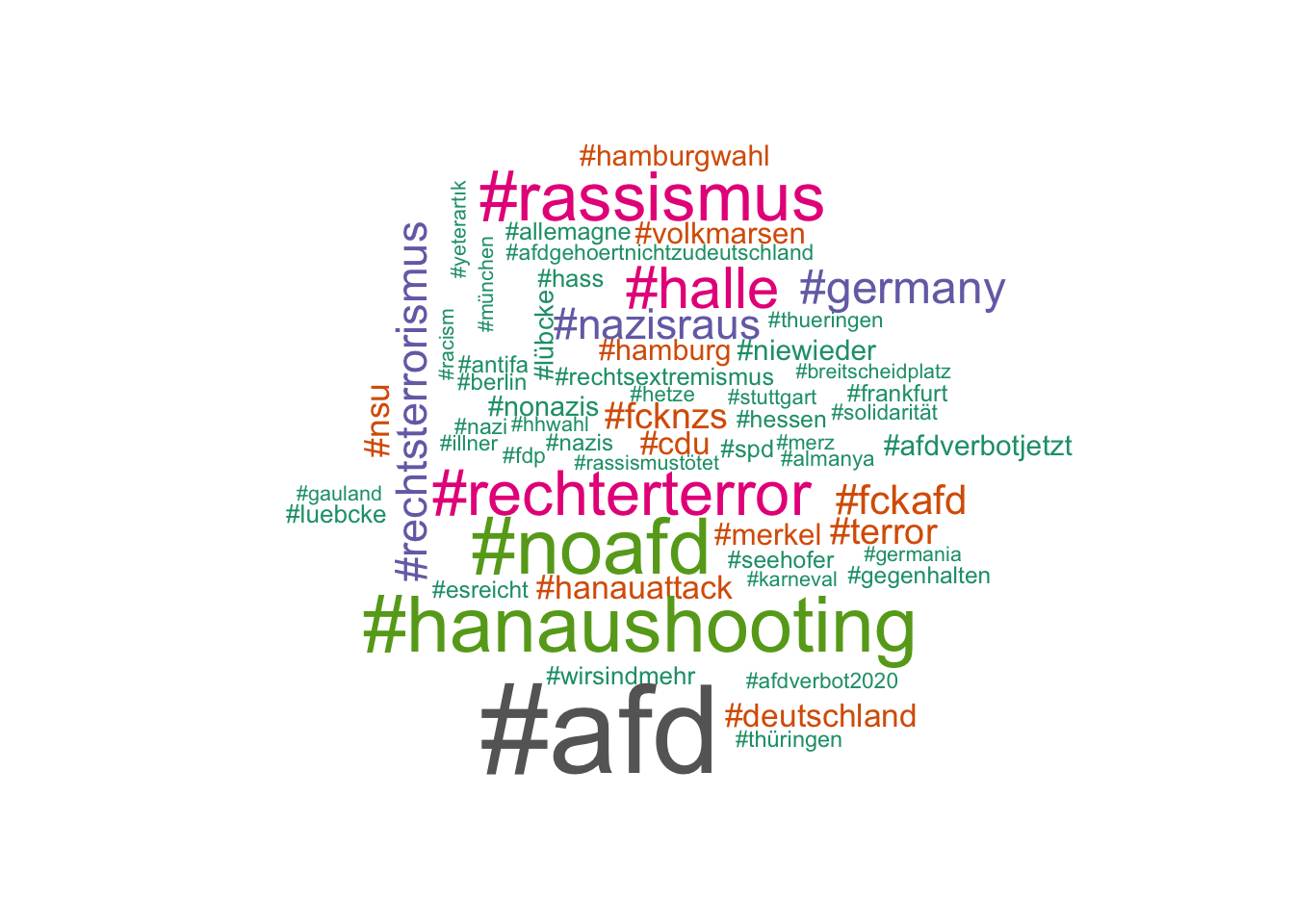This is a quick exploration of twitter reactions to the right-wing terrorist shootings in Hanau, Germany on 19th february 2020. I played around with this data as an excercise to get in first touch with Twitter analysis with R for sociological research. Most of the code is based this this tutorial.
Load Packages
# Data Import
library(jsonlite)
# Data Wrangling and Visualization
library(magrittr) # for piped function calls with %>%
library(plotly)
library(tidyverse)
# Date & Time Manipulation.
library(hms)
library(lubridate)
# Text Mining
library(tidytext)
library(wordcloud)
#Set notebook directory.
MAIN.DIR <- here::here()
Read the data
Load the data dump from the JSON-file.
all_tweets <- jsonlite::stream_in(file("../../../r-playground/data/hashtag_hanau_2020-02-19_2020_02_29_dump.json"), verbose = FALSE)
We have a total of 80.5k tweets with the hashtag #Hanau in our dataframe.
nrow(all_tweets)
## [1] 80549
Grab a subset of the data.
tweets_raw <- all_tweets %>%
select(datetime, text) %>%
filter(!str_detect(string = text, pattern = '@')) %>% # Remove account names
as_tibble()
Let’s parse the date string into a datetime in order to do a timeline analysis.
tweets_raw %<>%
mutate(
datetime = datetime %>%
parse_date_time(orders = ' %Y-%m-%d %H%M%S') # Parse date.
)
Timeline Analysis
Let’s first have a look at when the reactions have been posted.
# Set the time from UTC to CET (+1h).
tweets_raw %<>%
mutate(datetime = datetime + 1*60*60)
# Remove the seconds, so we can get a meaninful plot.
tweets_raw %<>%
mutate(created = datetime %>% round(units = 'mins') %>% as.POSIXct())
# Let's plot it.
plot <- tweets_raw %>%
count(created) %>%
ggplot(mapping = aes(x = created, y = n)) +
theme_light() +
geom_line() +
xlab(label = 'Date') +
ylab(label = NULL) +
ggtitle(label = 'Number of Tweets per Minute')
plot %>% ggplotly()
The shooting happened at 22:00 CET. There is a first peak of 27 tweets/minute a few hours after the shooting at 01:08 CET. The biggest peak in the data with 80 tweets/minute is at 20-02.20 14:04 CET, the day after the shooting. On the 2020-02-21 the number of tweets per minute is more than halved and continually decreases the next few days.
Hashtag Count
Which other hashtags have been combined with the hashtag #Hanau can shed some light on how the reactions are evaluated and framed by the public. So let’s inspect that.
# Function that gets hashtags of a tweet.
getHashtags <- function(tweet) {
hashtag.vector <- str_extract_all(string = tweet, pattern = '#\\S+', simplify = TRUE) %>%
as.character()
hashtag.string <- NA
if (length(hashtag.vector) > 0) {
hashtag.string <- hashtag.vector %>% str_c(collapse = ', ')
}
return(hashtag.string)
}
# Get the hashtags from our raw data.
hashtags <- tibble(
Hashtags = tweets_raw$text %>% map_chr(.f = ~ getHashtags(tweet = .x))
)
# Bind the hashtags to our normalized tweets.
tweets_raw %<>% bind_cols(hashtags)
# Unnest the hashtags.
hashtags.unnested.df <- tweets_raw %>%
select(created, Hashtags) %>%
unnest_tokens(input = Hashtags, output = hashtag)
# Count the usage of specific hashtags.
hashtags.unnested.count <- hashtags.unnested.df %>%
filter(hashtag != "hanau") %>% # Filter out #hanau, because that's the hashtag we used to scrape our data.
count(hashtag) %>%
drop_na()
# Plot the wordcloud.
wordcloud(
words = str_c('#',hashtags.unnested.count$hashtag),
freq = hashtags.unnested.count$n,
min.freq = 200,
colors=brewer.pal(8, 'Dark2')
)

The tag cloud sheds light on the most used hashtags within the reactions to hanau. Alot of the reactions use either hashtags calling the shooting by the name, either as right-wing terrorism/extremism (e.g. #rechtsterrorismus, #rechterterror or #nazisraus) or racism (e.g. #rassismus or #rassismustötet). On the two top ranks are hashtags linking the extreme right AfD-party with the event, as visible in this table of top hashtags.
hashtags.unnested.count %>%
arrange(desc(n)) %>%
head(20)
## # A tibble: 20 × 2
## hashtag n
## <chr> <int>
## 1 afd 4304
## 2 noafd 2509
## 3 hanaushooting 2500
## 4 rassismus 2117
## 5 rechterterror 1882
## 6 halle 1688
## 7 germany 1229
## 8 rechtsterrorismus 1121
## 9 nazisraus 1092
## 10 fckafd 1019
## 11 terror 839
## 12 fcknzs 835
## 13 nsu 749
## 14 hanauattack 695
## 15 deutschland 678
## 16 cdu 673
## 17 merkel 590
## 18 volkmarsen 588
## 19 hamburg 559
## 20 hamburgwahl 544
Conclusion
The results suggest that media attention on Twitter was highest on the day after the attack and then declined continuously, which corresponds to a common attention pattern for such events. The hashtag analysis also shows that the attack was interpreted by the public as an expression of right-wing extremism and directly linked to the AfD.